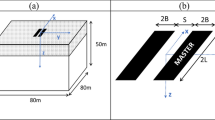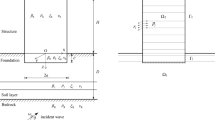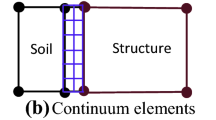Abstract
The need for simplified physical models representing frequency dependent soil impedances has been the motivation behind many researches throughout history. Generally, such models are generated to capture impedance functions in a wide range of excitation frequencies, which leads to relatively complex models. That is while there is just a limited range of frequencies that really influence the response of the structure. Here, a new methodology based on the response-matching concept is proposed, which can lead to the development of simpler discrete models. The idea is then used to upgrade an existing simple model of surface foundations to the case of embedded foundations. The applicability of the model in both frequency domain and time domain analyses of soil-structure systems with embedded foundations is discussed. Moreover, the accuracy of the results is compared with another existing discrete model for embedded foundations.
Similar content being viewed by others
References
Apsel RJ (1979), “Dynamic Green’s Functions for Layered Media and Applications to Boundary-Value Problems,” Ph.D. Dissertation, University of California, San Diego, CA.
Beredugo YO and Novak M (1972), “Coupled Horizontal and Rocking Vibration of Embedded Footings,” Canadian Geotechnical Journal, 9(4): 477–497.
Bielak J (1975), “Dynamic Behavior of Structures with Embedded Foundations,” Earthquake Engineering and Structural Dynamics, 3(3): 259–274.
Ehlers G (1942), “The Effect of Soil Flexibility on Vibrating Systems,” Beton und Eisen, 41: 197–203.
Federal Emergency Management Agency (FEMA), “Improvement of Nonlinear Static Seismic Analysis Procedures,” Report FEMA 440, Washington, DC, 2005.
Ghaffar-zadeh M and Chapel F (1983), “Frequency-Independent Impedances of Soil-structure Systems in Horizontal and Rocking Modes,” Earthquake Engineering and Structural Dynamics, 11: 523–540.
Ghannad MA and Ahmadnia A (2006), “The Effect of Soil Structure Interaction on Inelastic Structural Demands,” European Earthquake Engineering, 1: 23–35.
Ghannad MA, Fukuwa N and Nishizaka R (1998), “A Study on the Frequency and Damping of Soil-structure Systems Using a Simplified Model,” Journal of Structural Engineering, Architectural Institute of Japan (AIJ), 44B: 85–93.
Ghannad MA and Jahankhah H (2007), “Site-dependent Strength Reduction Factors for Soil-structure Systems,” Soil Dynamics and Earthquake Engineering, 27: 99–110.
Jean WY, Lin TW and Penzien J (1990), “System Parameters of Soil Foundations for Time Domain Dynamic Analysis,” Earthquake Engineering and Structural Dynamics, 19: 541–553.
Kausel E and Rosset JM (1975), “Dynamic Stiffness of Circular Foundations,” Journal of Engineering Mechanics, ASCE, 101: 771–785.
Khodabakhshi P (2009), “A Novel Discrete Model Proposal for Aanalysis of Soil-structure Systems in Time Domain,” M.S. Dissertation, Sharif University of Technology, Iran.
Kramer SL (1996), Geotechnical Earthquake Engineering, Prentice-Hall, Inc., Englewood Cliffs, New Jersey.
Luco JE and Westmann RA (1971), “Dynamic Response of Circular Footings,” Journal of Engineering Mechanics, ASCE, 97: 1381–1395.
Luco JE and Westmann RA (1972), “Dynamic Response of a Rigid Footing Bonded to an Elastic Halfspace,” Journal of Applied Mechanics, ASME, 39: 527–534.
Mahsuli M and Ghannad MA (2009), “The Effect of Foundation Embedment on Inelastic Response of Structures,” Earthquake Engineering and Structural Dynamics, 38: 423–437.
Meek JW and Veletsos AS (1974), “Simple Models for Foundations in Lateral and Rocking Motion,” Proceedings of 5th World Conference on Earthquake Engineering, Vol. II, Rome, Italy, 2610–2613.
Meek JW and Wolf JP (1992), “Cone Models for Homogeneous Soil I,” Journal of Geotechnical Engineering, ASCE, 118(5): 667–685.
Meek JW and Wolf JP (1994), “Cone Models for Embedded Foundation,” Journal of Geotechnical Engineering, ASCE, 120(1): 60–80.
Moghaddasi M, Cubrinovski M, Chase JG, Pampanin S and Carr A (2010), “Probabilistic Evaluation of Soil-foundation-structure Interaction Effects on Seismic Structural Response,” Earthquake Engineering and Structural Dynamics, DOI: 10.1002/eqe.1011.
Novak M and Sachs K (1973), “Torsional and Coupled Vibrations of Embedded Footings,” Earthquake Engineering and Structural Dynamics, 2: 11–33.
Saitoh M (2007), “Simple Model of Frequency-dependent Impedance Functions in Soil-structure Interaction Using Frequency-independent Elements,” Journal of Engineering Mechanics, ASCE, 133: 1101–1114.
Takewaki I, Takeda N and Uetani K (2003), “Fast Practical Evaluation of Soil-structure Interaction of Embedded Structures,” Soil Dynamics and Earthquake Engineering, 23: 195–202.
Ulrich CM and Kuhlemeyer RL (1973), “Coupled Rocking and Lateral Vibrations of Embedded Footings,” Canadian Geotechnical Journal, 10: 145–160.
Veletsos AS (1977), Dynamics of Structure-foundation Systems, Prentice-Hall, Inc., Englewood Cliffs, New Jersey.
Veletsos AS and Nair VD (1974), “Torsional Vibration of Viscoelastic Foundations,” Journal of Soil Mechanics and Foundation, ASCE, 100: 225–245.
Veletsos AS and Wei YT (1971), “Lateral and Rocking Vibrations of Footings,” Journal of Soil Mechanics and Foundations, ASCE, 97(9): 1227–1248.
Wolf JP (1991a), “Consistent Lumped-parameter Models for Unbounded Soil: Physical Representation,” Earthquake Engineering and Structural Dynamics, 20: 11–32.
Wolf JP (1991b), “Consistent Lumped-parameter Models for Unbounded Soil: Frequency-independent Stiffness, Damping and Mass Matrices,” Earthquake Engineering and Structural Dynamics, 20: 33–41.
Wolf JP (1994), Foundation Vibration Analysis Using Simple Physical Models, Prentice-Hall, Inc., Englewood Cliffs, New Jersey.
Wolf JP (1997), “Spring-dashpot-mass Models for Foundation Vibrations,” Earthquake Engineering and Structural Dynamics, 26: 931–949.
Wolf JP and Deeks AJ (2004), Foundation Vibration Analysis: A Strength of Materials Approach, Elsevier, Oxford.
Wolf JP and Preisig M (2003), “Dynamic Stiffness of Foundation Embedded in Layered Halfspace Based on Wave Propagation in Cones,” Earthquake Engineering and Structural Dynamics, 32: 1075–1098.
Wolf JP and Somaini DR (1986), “Approximate Dynamic Model of Embedded Foundation in Time Domain,” Earthquake Engineering and Structural Dynamics, 14: 683–703.
Wu HW and Chen CY (2002), “Simplified Soil-structure Interaction Analysis Using Efficient Lumped-parameter Models for Soils,” Soils and Foundations, 42: 41–52.
Wu HW and Lee HW (2002), “Systematic Lumped Parameter Models for Foundations Based on Polynomial Fraction Approximation,” Earthquake Engineering and Structural Dynamics, 31: 1383–1412.
Wu HW and Lee HW (2004), “Nested Lumped-parameter Models for Foundation Vibrations,” Earthquake Engineering and Structural Dynamics, 33: 1051–1058.
Author information
Authors and Affiliations
Corresponding author
Rights and permissions
About this article
Cite this article
Khodabakhshi, P., Jahankhah, H. & Ghannad, M.A. A discrete model for response estimation of soil-structure systems with embedded foundations. Earthq. Eng. Eng. Vib. 10, 263–276 (2011). https://doi.org/10.1007/s11803-011-0064-2
Received:
Accepted:
Published:
Issue Date:
DOI: https://doi.org/10.1007/s11803-011-0064-2




